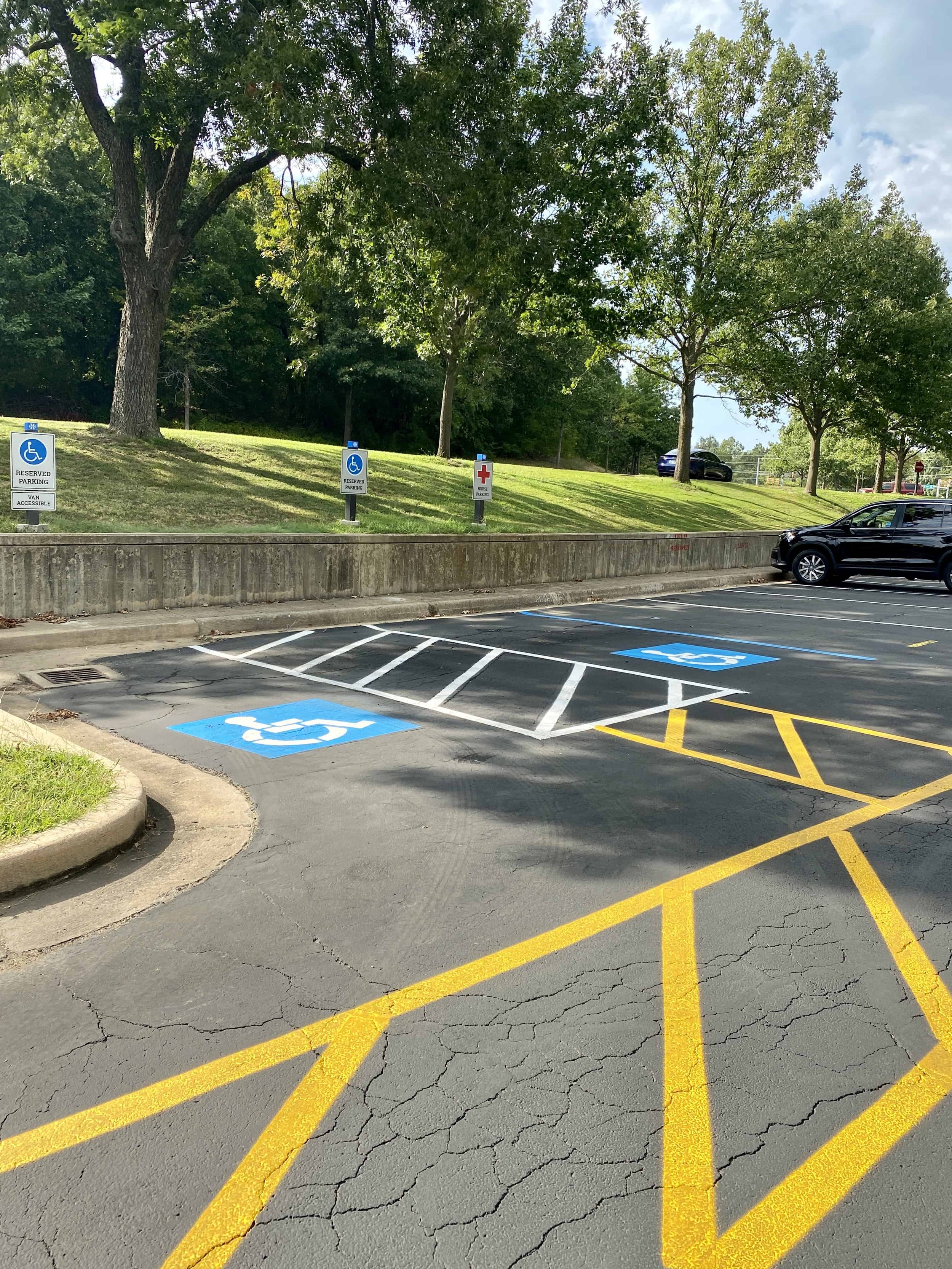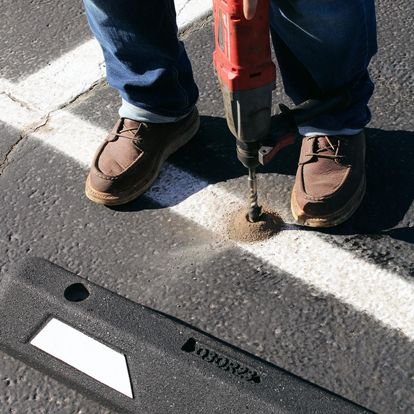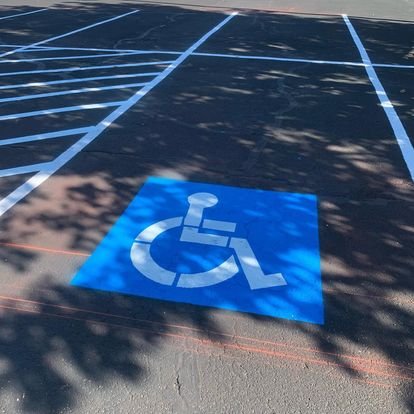What is Line Striping and Why Does Your Business Need it?
As a customer, your first impression starts the minute you’re pulling into a parking lot. They extend beyond the building itself to include the organization and safety of parking areas. Line striping is crucial in organizing traffic flow and ensuring safety for vehicles and pedestrians alike. Road marking goes beyond painting; it requires planning to keep traffic flowing, reduce accidents, and make the most of space.
Parking lot lines help customers find parking spots. They also help customers stay safe while walking. Additionally, they help customers know where to park different types of vehicles.
This is especially important as more cars are on the road. For businesses, understanding the benefits and legal needs of line striping is key. Properly marked pavements not only improve a property's look but also safeguard those who use the parking lot.
What is Line Striping?
Line striping is using water based or oil based paint on roads or sidewalks to show where vehicles and pedestrians should go. Parking lots are organized by marking parking spots. The classic example of improving safety most people can see is walmart parking lots. Large crosswalks by the doors, large handicap parking areas, well organized stalls and traffic flow through the lot. A well-striped parking lot will dramatically change the overall safety of the patrons in the lot.
What Are the Different Types of Line Striping?
Thermoplastic, Epoxy, Oil or solvent based, and Water based Paints
In line striping, the choice of material can significantly impact durability, visibility, and application method. Four common materials for line striping are thermoplastic, solvent-based paints, epoxy, and waterborne paints, each with different uses.
Solvent-Based Paints
Before the rise of waterborne options, solvent-based paints were the standard for line striping. They offer excellent durability and adherence to the pavement, making them suitable for high-traffic areas. These products have more Volatile Organic Compounds (VOC), which makes them less eco-friendly. As a result, some areas have stricter rules on where and how they can use them. For our regions there are no issues with solvent or oil-based paint.
Oil based is usually longer lasting than water based. On Concrete lots, oil-based or Thermoplastic is the go-to because it lasts for so much longer. On freshly sealed asphalt you want to use water based. The sealer is designed to wear down and fade, and you don’t want to put long lasting paint on a non-long lasting surface. You’re not getting your money’s worth out of it.
Thermoplastic Line Striping
Thermoplastic line striping has a reputation for its long-lasting durability and high visibility. This material is a mixture of glass beads, pigments, and binder that melts when heated, forming a hard, wear-resistant marking once cooled.
Ideal for high-traffic areas like roads and highways, thermoplastic markings can last up to several years. They're particularly valued for their reflectivity at night, enhancing safety in low-light conditions. It’s very rare to use thermoplastic on an asphalt parking lot.
Epoxy Line Striping
Epoxy line striping is a strong and durable option made of two components that create a tough surface resistant to chemicals. Its durability and longevity make it perfect for high-traffic areas such as parking structures and manufacturing plants. Epoxy is a sturdy substance capable of enduring wear and tear over an extended period.
Epoxy is often utilized in areas with high vehicle traffic due to its durability and long-lasting nature. Although it provides superior resistance to wear and tear, epoxy can be more difficult to alter or remove compared to other striping materials. We see City engineers request this a lot for downtown areas. In most parking lot applications, the benefit isn’t worth the cost.
Waterborne Line Striping Paints
Waterborne paints offer the most environmentally friendly option and people widely use them for both indoor and outdoor applications. These paints dry by water evaporating and the solids hardening, making them safer and easier to use with less smell and harm.
Waterborne paints are ideal for parking lots, school playgrounds, and low-traffic roads. They offer good durability and visibility, but may require more frequent reapplication compared to thermoplastic, Oil, and epoxy. Freshly sealed asphalt parking lots where the sealer is designed to wear thin over time are ideal for water-based paint. It will naturally fade with the sealer and need to be refreshed. Water based paint is usually very quick to apply and dry and very cost effective.
Why is Line Striping Important in a Parking Lot?
Line striping in a parking lot is crucial for several compelling reasons, primarily focusing on safety and efficiency. This seemingly simple addition to pavement significantly impacts how drivers and pedestrians navigate parking areas, directly contributing to a safer and more orderly environment.
Safety:
Line striping creates clear paths for vehicles and pedestrians, making accidents less likely. Crosswalks, stop lines, and arrows help people navigate the parking area safely. This makes sure pedestrians and drivers know their surroundings and possible dangers. This clarity is essential in preventing mishaps and ensuring that everyone can move through the parking lot safely.
Efficiency:
Besides safety, line striping enhances the efficiency of parking lot usage. Marking parking spaces and traffic flow directions helps maximize space and accommodate more vehicles without confusion. This helps to decrease traffic congestion in parking lots. Making it easier for people to enter and exit without any delays or frustration.
Curb Appeal:
Beyond the functional benefits, a well-striped parking lot significantly boosts the property's curb appeal. Fresh, bright markings on a clean asphalt surface make a strong first impression on visitors, signaling a well-maintained and professional establishment. Fresh markings on pavement aren’t noticed until you see it. When you drive on a lot with well thought out and clear striping you notice it. This aesthetic improvement can attract more customers and enhance the overall image of the business.
How Long Does Paint Last on Asphalt?
The durability of paint on asphalt surfaces depends on several factors. These factors include the type of paint, the amount of traffic, the weather, and the quality of the asphalt surface. Generally, the lifespan of line striping can range from a few months to several years, depending on these conditions.
Type of Paint
The choice of paint plays a significant role in how long the markings will last. People often use water-based acrylic paints for their eco-friendly qualities and easy application. They can typically last between 1 months to 3 years in moderately trafficked areas.
Thermoplastic markings are durable and can last over 5 years, making them great for busy areas. Epoxy paints are incredibly strong and last a long time, like thermoplastic. People often use them in industrial places or parking garages because they can handle heavy weights and spills.
Traffic Volume
High-traffic areas tend to wear down striping more quickly because of the constant friction from vehicle tires. Parking lots, intersections, and crosswalks that see heavy use may require more frequent reapplication of paint to maintain visibility and safety.
Environmental Conditions
Weather plays a crucial role in the longevity of pavement markings. Harsh winters, extreme temperatures, and exposure to sunlight can accelerate the degradation of paint. Water-based paints fade faster in rainy or snowy areas because water can damage them easily. Solvent-based and thermoplastic paints are more resistant to water damage.
Surface Preparation and Application Quality
Proper surface preparation before application is crucial for paint adherence and longevity. A clean, dry, and slightly rough surface allows the paint to bond more effectively, extending its lifespan. The quality of the application, like the paint thickness and following manufacturer guidelines, impacts how long the markings will stay.
Maintenance plays a crucial role in extending the life of line striping. Regularly checking and fixing faded or damaged markings can make pavement markings last longer. Regular maintenance keeps asphalt surfaces safe, functional, and good appearance for a long time.
How Regional Groundwork Can Help With This
Expertise in Asphalt Line Striping
Regional Groundwork is your premier partner for asphalt line striping services in the Greater Tulsa and Oklahoma City, and northwest Arkansas areas. We are extremely familiar with the area, want this place to look beautiful, want our communities safer, and want to be your resource as long as you have a parking lot.
We commit to doing an excellent job. This makes us the top choice for your line striping needs. We bring our experience to every project, employing modern equipment and the highest quality paints to ensure durable markings resistant to time and weather. Our crews are professional, clean, and communicative. If a problem or change comes up on site we’ll communicate that with you to find the best solution.
Tailored Solutions for Every Need
At Regional Groundwork, we build lasting relationships with clients. We do this by ensuring their spaces are safe, efficient, and appealing. Our goal is to go beyond just providing a service. Request a quote and elevate your property’s appeal and functionality.












